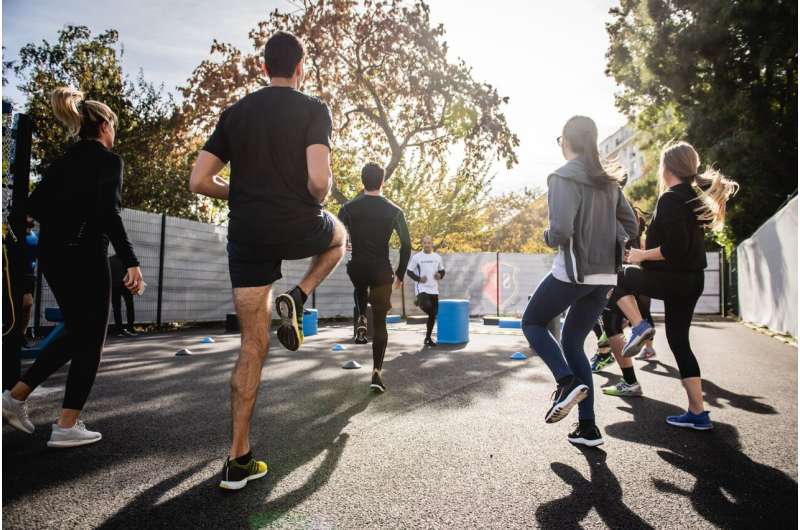This article has been reviewed according to Science X's editorial process and policies. Editors have highlighted the following attributes while ensuring the content's credibility:
fact-checked
peer-reviewed publication
trusted source
proofread
Most forms of exercise are overwhelmingly safe, but don't ignore the dangers

The risks of serious injury from most sports and exercise are astonishingly small, according to the results of a five-year study led by researchers at the University of Bath.
The study
, which was published Oct. 25 in the journal Injury Prevention, shows that even forms of sport sometimes considered risky by the public, such as road cycling, are generally safe, suggesting the benefits of taking part in fitness activities far outweigh the dangers. This is the first time in England and Wales that researchers have attempted to describe and quantify the relative risks of trauma resulting from sport or some other physical activity. It is hoped that the study's results will make it easier for both participants and organizers of activities to make their pursuits safer still. Data for the new study came from hospitals nationwide, where participants of sports and exercise presented with major trauma. The researchers found that between 2012 and 2017, a total of 11,702
Dr. Sean Williams, a researcher at the Department for Health and the Center for health and Injury and Illness Prevention at the University of Bath, and principal investigator of the study, said, "This work demonstrates that engaging in fitness activities is overwhelmingly a safe and beneficial pursuit.
"While no physical activity is entirely without risk, the chance of serious injury is exceedingly low when compared to the myriad health and wellness advantages gained from staying active."
The study examined 61 sports and other physical activities undertaken nationally, irrespective of their popularity, and provided a comparable estimate of the risks to participants.
Perhaps unsurprisingly, fitness activities (such as running, golf, dance classes and gym sessions) are the least likely pursuits to result in injury. Running results in 0.70 injuries, golf 1.25 injuries and fitness classes just 0.10 per 100,000 participants/year.
Among sports with the highest participation, football had the highest injury incidence rate (6.56 injuries/100,000 participants/year), though this too is relatively small.
Motorsports, equestrian activities and gliding (paragliding and hang gliding) were by far the riskiest activities of those studied, with motorsports resulting in 532 injuries, equestrian pursuits 235 and gliding 191 injuries per 100,000 participants.
Male incidence (6.4 injuries/100,000 participants/year) was higher than female incidence (3.3 injuries/100,000 participants/year.
Why is exercise getting riskier?
Perhaps concerningly, injury risks for popular sports and other physical activities are increasing internationally. In Victoria, Australia, for instance, the annual rate of hospital-treated sports injury increased by 24% between 2004 and 2010, with an incidence of sport-related major trauma or death of 12.2 per 100,000 participants/year.
This trend is mirrored in the U.K. Highlighting this is data from one regional trauma and spine unit, which identified an almost 500% increase in the incidence of serious motorsports accidents in the five years to 2015.
Dr. Madi Davies, the study's lead author and former post-doctoral researcher at the University of Bath, said, "When I looked at the injuries recorded in 2012—the year the study started—it was clear that the risks were considerably lower than they were in later years of the study."
She called for further research, "in real-time," to understand exactly how and why more people are getting injured.
She said, "Though the finding that more people are getting injured could be multifaceted—trauma data recording has improved during the study, which means more injuries are now recorded—it's important that any increases in burden are responded to, and that this data is used to make activities safer."
Eliminating risk
Serious injury is a clear burden for participants who are hospitalized, their families and the NHS, and the aim of this study is to reduce these burdens by unpacking the injury risk of each activity and then coordinating action.
"Many sport and recreation injuries are preventable," said Dr. Williams. "Whether that be through protective equipment, rule or law changes, or education, once we identify how and where injuries are occurring, we can start to think about ways to prevent them in each sport."
It is hoped that this work will lead to the development of a national register with real-time data analysis opportunities. The register would standardize the recording of serious injuries resulting from sports and physical activity, so that trends or patterns in risk can be quickly identified and acted upon.
An example of where this has already happened relates to trampoline safety. Sales of garden trampolines took off in 2005 and by 2014, up to 250,000 were sold in the U.K. The Royal Society for the Prevention of Accidents (RoSPA), working with the royal College of Emergency Medicine, identified a spike in trampoline-related injuries and issued recommendations for improving safety, which ranged from limiting trampolining to one person at a time, keeping children aged under 6 off trampolines and buying models that are enclosed by a safety net.
In addition, trampoline manufacturers were supported to meet safety standards, for instance by adding padding around trampolines. Commercial partners were also involved, to improve safety at trampoline parks.
As a result of the RoSPA guidance, serious accidents have dropped significantly.
More information: Madeleine Davies et al, Sport-related major trauma incidence in young people and adults in England and Wales: a national registry-based study, Injury Prevention (2023). DOI: 10.1136/ip-2023-044887




















